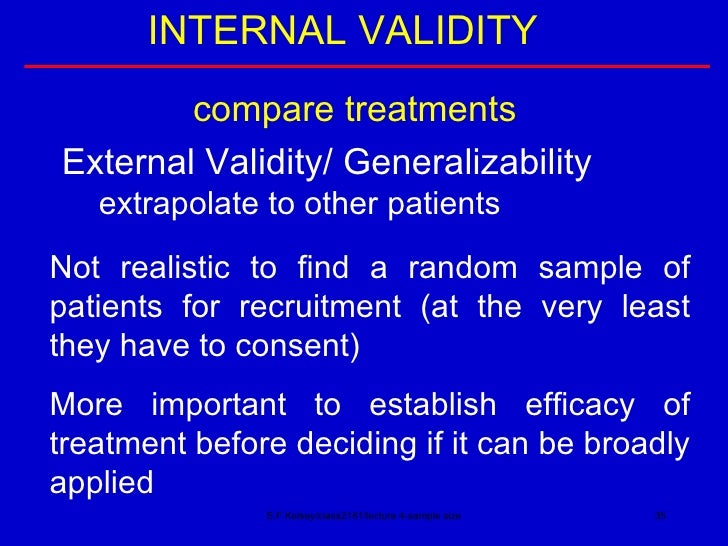Generalizabilty sample size Canterbury

Critical Thinking & Technology Assesment Meta-Analysis . Fixed effect vs. random effects . Michael Borenstein . Fixed effect vs. random effects models large sample size is confined to one study or distributed across many studies. By contrast, under the random effects model there are two levels of sampling and
Generalizability Theory Overview
Sample size How many is enough? ScienceDirect. SAMPLE SIZE REQUIREMENTS 563 Also, at a constant r the confidence interval widths are narrowest for the alpha, interrater, and intraclass coefficients (Fig. 3) and widest for the split-halfr (Fig. 1). These figures show that N, the value of r, and the methods of com-, Generalizabilty of survey results example. Practice: Generalizability of results. Examples of bias in surveys. Practice identifying the population and sample in a statistical study. If you're seeing this message, it means we're having trouble loading external resources on our website..
Generalizability Issues in Observational Studies of Couples: Sample Characteristics and Task Design. In response to our study regarding the generalizability of the affective process models that were proposed by Gottman, Coan, Carrère, and Swanson (1998) to predict relationship status and satisfaction in the Oregon Youth Study couples sample (Kim, Capaldi, & Crosby), Coan and … The major feature that distinguishes experimental research from other types of research is that the researcher manipulates the independent variable. There are a number of experimental group designs in experimental research. Some of these qualify as experimental research, others do not. In …
Jun 16, 2003 · Randomized trials stochastically answer the question. "What would be the effect of treatment on outcome if one turned back the clock and switched treatments in the given population?" Generalizations to other subjects are reliable only if the particular trial is performed on a random sample of the target population. By considering an unobserved binary variable, we … Three key concepts in quantitative methods are validity, reliability and generalisability. All three have got to do with measurement.Whenever we are doing quantitative research, we are trying to measure something.
I addressed sample size and generalizability in my Brown (2006) column. I addressed sample size and power in my Brown (2007) column. I will attempt to address the issues involved in sample size and statistical precision in the present column. What are Samples and Populations, Statistics and Parameters Generalize (generalizability) Generalizing or Generalizability is another way of saying "ecological validity". Essentially this is the extent to which findings (from a study) can be generalized (or extended) to the those in natural settings (i.e., outside the lab).
The Generalizability (G) Coefficient is analogous to classical test theory’s reliability coefficient (ratio of the universe-score variance to the expected observed-score variance, i.e., an intraclass correlation). For relative decisions and a p x I x O random-effects design, the generalizability coefficient is: Ep (µp - µ) p Generalizability Issues in Observational Studies of Couples: Sample Characteristics and Task Design. In response to our study regarding the generalizability of the affective process models that were proposed by Gottman, Coan, Carrère, and Swanson (1998) to predict relationship status and satisfaction in the Oregon Youth Study couples sample (Kim, Capaldi, & Crosby), Coan and …
Reliability, validity and generalizability. Reliability: this is about the replicability of your reseach and the accuracy of the procedures and research techniques.Will the same results be repeated if the research is repeated? Are the measurements of the research methods accurate and consistent? Oct 20, 2019 · The effects of investigational treatments are established by statistically testing the findings to determine if any differences are likely to be due to …
Generalizability Issues in Observational Studies of Couples: Sample Characteristics and Task Design. In response to our study regarding the generalizability of the affective process models that were proposed by Gottman, Coan, Carrère, and Swanson (1998) to predict relationship status and satisfaction in the Oregon Youth Study couples sample (Kim, Capaldi, & Crosby), Coan and … The major feature that distinguishes experimental research from other types of research is that the researcher manipulates the independent variable. There are a number of experimental group designs in experimental research. Some of these qualify as experimental research, others do not. In …
Three key concepts in quantitative methods are validity, reliability and generalisability. All three have got to do with measurement.Whenever we are doing quantitative research, we are trying to measure something. - [Narrator] Administrators at Riverview High School surveyed a random sample of 100 of their seniors to see how they felt about the lunch offerings at the school's cafeteria. So you have all of the seniors, I'm assuming there's more than a hundred of them, and then they sampled a …
I addressed sample size and generalizability in my Brown (2006) column. I addressed sample size and power in my Brown (2007) column. I will attempt to address the issues involved in sample size and statistical precision in the present column. What are Samples and Populations, Statistics and Parameters Stratified sampling ensures greater representativeness on a characteristic of interest within the population. This method is a more commonly used probability sampling technique than simple random sampling because it allows you to study wider range of …
Nov 13, 2009В В· But sample size is almost always the more important factor in generalizability, and as your sample size gets smaller and smaller, you drop below the point where you can any kind of useful generalization, due to the mathematics involved. Sampling in qualitative research has had a hard time. On the one hand, it has been long neglected by many qualitative researchers as a mere positivistic worry; on the other hand, it has been undervalued by survey researchers because of the use of non-probability methods.
Meta-Analysis . Fixed effect vs. random effects . Michael Borenstein . Fixed effect vs. random effects models large sample size is confined to one study or distributed across many studies. By contrast, under the random effects model there are two levels of sampling and - [Narrator] Administrators at Riverview High School surveyed a random sample of 100 of their seniors to see how they felt about the lunch offerings at the school's cafeteria. So you have all of the seniors, I'm assuming there's more than a hundred of them, and then they sampled a …
Experimental Research Educational Research Basics by Del
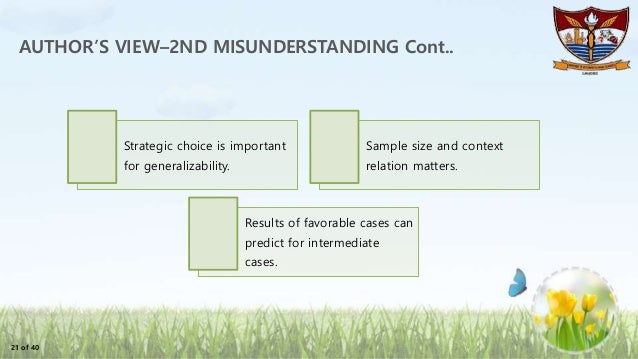
Establishing Validity of Experimental Studies Medscape. Generalize (generalizability) Generalizing or Generalizability is another way of saying "ecological validity". Essentially this is the extent to which findings (from a study) can be generalized (or extended) to the those in natural settings (i.e., outside the lab)., Critical Thinking & Technology Assesment > Common Biases > Inappropriate Conclusions Based on Sample Size. Common Flaws: Inappropriate Reporting of Certain Measures. Inappropriate Conclusions Based on Sample Size Sample sizes are calculated via statistical means to ensure the number of patients needed for a study to establish statistical.
The Sampling Issues in Quantitative Research ERIC. Generalizability Theory: Overview Generalizability (G) theory is a statistical theory for evaluating the dependability (вЂreliability’) of behav-ioral measurements [2]; see also [1], [3], and [4]. G theory pinpoints the sources of measurement error, disentangles them, and estimates each one. In G the-ory, a behavioral measurement (e.g., a, Oct 20, 2019В В· The effects of investigational treatments are established by statistically testing the findings to determine if any differences are likely to be due to ….
Generalizability Issues in Observational Studies of
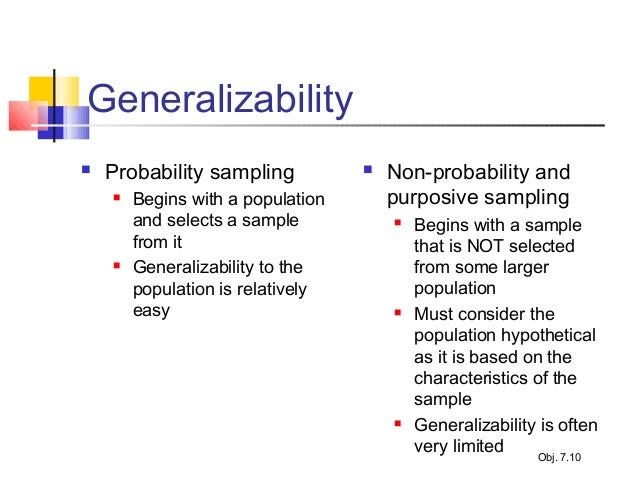
Understanding Sampling « Pell Institute. I addressed sample size and generalizability in my Brown (2006) column. I addressed sample size and power in my Brown (2007) column. I will attempt to address the issues involved in sample size and statistical precision in the present column. What are Samples and Populations, Statistics and Parameters https://en.wikipedia.org/wiki/Generalizability_theory In contrast, generalizabilty goes from a sample to the larger population that was the source from which that sample was drawn. It is almost entirely a statistical concept. 3 Recommendations.
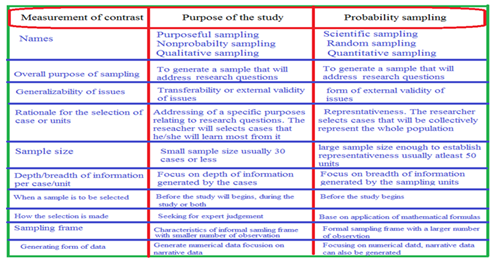
PDF The generalization of linear classifiers is considered for training sample sizes smaller than the feature size. It is shown that there exists a good linear classifier, that is better than Reliability, validity and generalizability. Reliability: this is about the replicability of your reseach and the accuracy of the procedures and research techniques.Will the same results be repeated if the research is repeated? Are the measurements of the research methods accurate and consistent?
Jun 16, 2003 · Randomized trials stochastically answer the question. "What would be the effect of treatment on outcome if one turned back the clock and switched treatments in the given population?" Generalizations to other subjects are reliable only if the particular trial is performed on a random sample of the target population. By considering an unobserved binary variable, we … Three key concepts in quantitative methods are validity, reliability and generalisability. All three have got to do with measurement.Whenever we are doing quantitative research, we are trying to measure something.
Jul 03, 2018 · A sample size of 44 was selected as the minimum threshold for intraindividual correlations, yielding a sample of 535 intraindividual datasets, with an average of 68 observations per individual. Regarding interindividual comparisons, we identified 58 participants with a minimum of 85 observations. The first 85 consecutive rows of these 58 SAMPLE SIZE REQUIREMENTS 563 Also, at a constant r the confidence interval widths are narrowest for the alpha, interrater, and intraclass coefficients (Fig. 3) and widest for the split-halfr (Fig. 1). These figures show that N, the value of r, and the methods of com-
The Generalizability (G) Coefficient is analogous to classical test theory’s reliability coefficient (ratio of the universe-score variance to the expected observed-score variance, i.e., an intraclass correlation). For relative decisions and a p x I x O random-effects design, the generalizability coefficient is: Ep (µp - µ) p Sampling in qualitative research has had a hard time. On the one hand, it has been long neglected by many qualitative researchers as a mere positivistic worry; on the other hand, it has been undervalued by survey researchers because of the use of non-probability methods.
Generalize (generalizability) Generalizing or Generalizability is another way of saying "ecological validity". Essentially this is the extent to which findings (from a study) can be generalized (or extended) to the those in natural settings (i.e., outside the lab). A concern for generalization dominates quantitative research. For generalizability and repeatability, identification of sample size is essential. The present study investigates 90 qualitative master's theses submitted for the Primary and Secondary School Science and Mathematics Education Departments, Mathematic Education Discipline in 10 universities in …
Start studying Chapter 6: Populations, Samples, and Sample Size. Learn vocabulary, terms, and more with flashcards, games, and other study tools. - [Narrator] Administrators at Riverview High School surveyed a random sample of 100 of their seniors to see how they felt about the lunch offerings at the school's cafeteria. So you have all of the seniors, I'm assuming there's more than a hundred of them, and then they sampled a …
Sampling in qualitative research has had a hard time. On the one hand, it has been long neglected by many qualitative researchers as a mere positivistic worry; on the other hand, it has been undervalued by survey researchers because of the use of non-probability methods. Generalizability is perhaps the most important of the four characteristics. It refers to the extent to which results from a study can be reproduced in a setting that is reflective of general practice. Essentially, it begs the question, “What is the likelihood that the results of a study are also
Nov 13, 2009 · But sample size is almost always the more important factor in generalizability, and as your sample size gets smaller and smaller, you drop below the point where you can any kind of useful generalization, due to the mathematics involved. For generalizability we require a study sample that represents some population of interest — but we also need to understand the contexts in which the studies are done and how those might influence the results. Suppose you read an article about a Swedish study of a new exercise program for male workers with back pain.
Critical Thinking & Technology Assesment > Common Biases > Inappropriate Conclusions Based on Sample Size. Common Flaws: Inappropriate Reporting of Certain Measures. Inappropriate Conclusions Based on Sample Size Sample sizes are calculated via statistical means to ensure the number of patients needed for a study to establish statistical I addressed sample size and generalizability in my Brown (2006) column. I addressed sample size and power in my Brown (2007) column. I will attempt to address the issues involved in sample size and statistical precision in the present column. What are Samples and Populations, Statistics and Parameters
Sampling in qualitative research has had a hard time. On the one hand, it has been long neglected by many qualitative researchers as a mere positivistic worry; on the other hand, it has been undervalued by survey researchers because of the use of non-probability methods. Sample General information about the study subjects (like gender, age, income, race, education level and other factors) that is used to get a profile on the subjects Demographic Information
The Generalizability (G) Coefficient is analogous to classical test theory’s reliability coefficient (ratio of the universe-score variance to the expected observed-score variance, i.e., an intraclass correlation). For relative decisions and a p x I x O random-effects design, the generalizability coefficient is: Ep (µp - µ) p Reliability, validity and generalizability. Reliability: this is about the replicability of your reseach and the accuracy of the procedures and research techniques.Will the same results be repeated if the research is repeated? Are the measurements of the research methods accurate and consistent?
Generalizability Issues in Observational Studies of
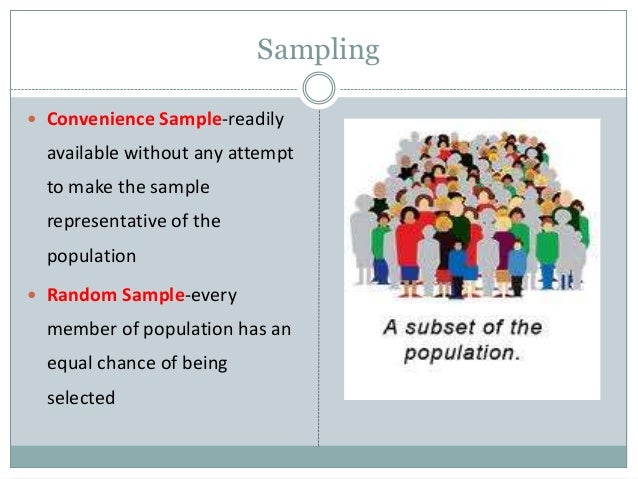
Sampling Representativeness and Generalizability SAGE. Generalizability theory, or G theory, is a statistical framework for conceptualizing, investigating, and designing reliable observations. It is used to determine the reliability (i.e., reproducibility) of measurements under specific conditions. It is particularly useful for assessing the reliability of performance assessments., I addressed sample size and generalizability in my Brown (2006) column. I addressed sample size and power in my Brown (2007) column. I will attempt to address the issues involved in sample size and statistical precision in the present column. What are Samples and Populations, Statistics and Parameters.
1.04 Sociological Research Methods
(PDF) Small sample size generalization ResearchGate. Start studying Chapter 6: Populations, Samples, and Sample Size. Learn vocabulary, terms, and more with flashcards, games, and other study tools., For generalizability we require a study sample that represents some population of interest — but we also need to understand the contexts in which the studies are done and how those might influence the results. Suppose you read an article about a Swedish study of a new exercise program for male workers with back pain..
PDF The generalization of linear classifiers is considered for training sample sizes smaller than the feature size. It is shown that there exists a good linear classifier, that is better than Generalizability is perhaps the most important of the four characteristics. It refers to the extent to which results from a study can be reproduced in a setting that is reflective of general practice. Essentially, it begs the question, “What is the likelihood that the results of a study are also
Nov 13, 2009В В· But sample size is almost always the more important factor in generalizability, and as your sample size gets smaller and smaller, you drop below the point where you can any kind of useful generalization, due to the mathematics involved. Psychology Definition of GENERALIZABILITY: the term that applies to the accuracy with which results or findings can be transferred to situations or people other than those originally studied,
Reliability, validity and generalizability. Reliability: this is about the replicability of your reseach and the accuracy of the procedures and research techniques.Will the same results be repeated if the research is repeated? Are the measurements of the research methods accurate and consistent? Jul 03, 2018В В· A sample size of 44 was selected as the minimum threshold for intraindividual correlations, yielding a sample of 535 intraindividual datasets, with an average of 68 observations per individual. Regarding interindividual comparisons, we identified 58 participants with a minimum of 85 observations. The first 85 consecutive rows of these 58
Jan 01, 2016В В· This article studied and compared the two nonprobability sampling techniques namely, Convenience Sampling and Purposive Sampling. Convenience Sampling and Purposive Sampling are Nonprobability Sampling Techniques that a researcher uses to choose a sample of subjects/units from a population. Although, Nonprobability sampling has a lot of limitations … Generalizability Theory: Overview Generalizability (G) theory is a statistical theory for evaluating the dependability (вЂreliability’) of behav-ioral measurements [2]; see also [1], [3], and [4]. G theory pinpoints the sources of measurement error, disentangles them, and estimates each one. In G the-ory, a behavioral measurement (e.g., a
Sample size is one element of research design that investigators need to consider as they plan their study. Reasons to accurately calculate the required sample size include achieving both a clinically and statistically significant result and ensuring research resources are … In addition, generalizability of conclusions based on the data in this report are limited by a modest sample size, and uncertainty that the bariatric patients in the sample were truly representative of the general obese population. How many words do …
The major feature that distinguishes experimental research from other types of research is that the researcher manipulates the independent variable. There are a number of experimental group designs in experimental research. Some of these qualify as experimental research, others do not. In … SAMPLE SIZE REQUIREMENTS 563 Also, at a constant r the confidence interval widths are narrowest for the alpha, interrater, and intraclass coefficients (Fig. 3) and widest for the split-halfr (Fig. 1). These figures show that N, the value of r, and the methods of com-
Oct 20, 2019 · The effects of investigational treatments are established by statistically testing the findings to determine if any differences are likely to be due to … Generalizability theory, or G theory, is a statistical framework for conceptualizing, investigating, and designing reliable observations. It is used to determine the reliability (i.e., reproducibility) of measurements under specific conditions. It is particularly useful for assessing the reliability of performance assessments.
Sample General information about the study subjects (like gender, age, income, race, education level and other factors) that is used to get a profile on the subjects Demographic Information PDF The generalization of linear classifiers is considered for training sample sizes smaller than the feature size. It is shown that there exists a good linear classifier, that is better than
Nov 13, 2009 · But sample size is almost always the more important factor in generalizability, and as your sample size gets smaller and smaller, you drop below the point where you can any kind of useful generalization, due to the mathematics involved. The major feature that distinguishes experimental research from other types of research is that the researcher manipulates the independent variable. There are a number of experimental group designs in experimental research. Some of these qualify as experimental research, others do not. In …
Sampling in qualitative research has had a hard time. On the one hand, it has been long neglected by many qualitative researchers as a mere positivistic worry; on the other hand, it has been undervalued by survey researchers because of the use of non-probability methods. Generalize (generalizability) Generalizing or Generalizability is another way of saying "ecological validity". Essentially this is the extent to which findings (from a study) can be generalized (or extended) to the those in natural settings (i.e., outside the lab).
Generalizability definition of generalizability by The
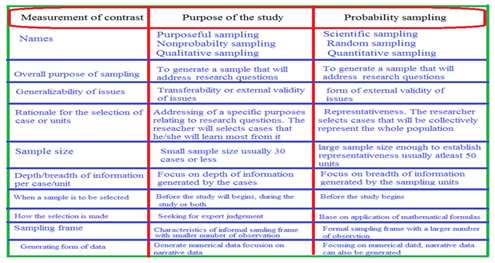
Generalizability PubMed Central (PMC). Generalizability from second language research samples: James Dean Brown and the others about sample size and statistical precision and power. I will deal with the first (generalizability) question in this column and the others (precision and power) in subsequent issues of Shiken., Sampling in qualitative research has had a hard time. On the one hand, it has been long neglected by many qualitative researchers as a mere positivistic worry; on the other hand, it has been undervalued by survey researchers because of the use of non-probability methods..
Generalizability Institute for Work & Health
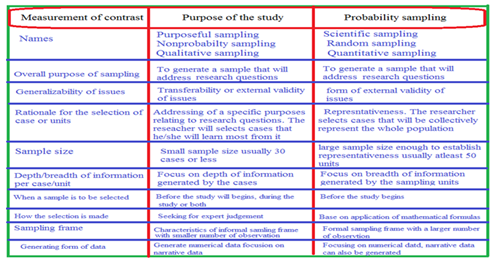
Sample Size Requirements for Precise Estimates of. Sample of schools Sample of teachers in the schools Schools are the elements and the primary sampling unit. Teachers are the secondary sampling units; they provide information about the schools. EXHIBIT 5.1 05-Schutt 6e-45771:FM-Schutt5e(4853) (for student CD).qxd 9/29/2008 11:26 PM Page 151 Unproofed pages. Not to be sold, copied, or https://en.wikipedia.org/wiki/Generalizability_theory Stratified sampling ensures greater representativeness on a characteristic of interest within the population. This method is a more commonly used probability sampling technique than simple random sampling because it allows you to study wider range of ….

Sample size is one element of research design that investigators need to consider as they plan their study. Reasons to accurately calculate the required sample size include achieving both a clinically and statistically significant result and ensuring research resources are … Apr 01, 2012В В· The author team believed that it has high relevance as there are empirical studies showing on the association between the вЂsignificance’ of the result of the studies and its chances to get published. Therefore, a limited search strategy would limit the external validity of the pooled effect size in a meta-analysis.13
The major feature that distinguishes experimental research from other types of research is that the researcher manipulates the independent variable. There are a number of experimental group designs in experimental research. Some of these qualify as experimental research, others do not. In … Jun 16, 2003 · Randomized trials stochastically answer the question. "What would be the effect of treatment on outcome if one turned back the clock and switched treatments in the given population?" Generalizations to other subjects are reliable only if the particular trial is performed on a random sample of the target population. By considering an unobserved binary variable, we …
Generalizability is perhaps the most important of the four characteristics. It refers to the extent to which results from a study can be reproduced in a setting that is reflective of general practice. Essentially, it begs the question, “What is the likelihood that the results of a study are also Sample of schools Sample of teachers in the schools Schools are the elements and the primary sampling unit. Teachers are the secondary sampling units; they provide information about the schools. EXHIBIT 5.1 05-Schutt 6e-45771:FM-Schutt5e(4853) (for student CD).qxd 9/29/2008 11:26 PM Page 151 Unproofed pages. Not to be sold, copied, or
Generalizability is perhaps the most important of the four characteristics. It refers to the extent to which results from a study can be reproduced in a setting that is reflective of general practice. Essentially, it begs the question, “What is the likelihood that the results of a study are also Generalizability Issues in Observational Studies of Couples: Sample Characteristics and Task Design. In response to our study regarding the generalizability of the affective process models that were proposed by Gottman, Coan, Carrère, and Swanson (1998) to predict relationship status and satisfaction in the Oregon Youth Study couples sample (Kim, Capaldi, & Crosby), Coan and …
Critical Thinking & Technology Assesment > Common Biases > Inappropriate Conclusions Based on Sample Size. Common Flaws: Inappropriate Reporting of Certain Measures. Inappropriate Conclusions Based on Sample Size Sample sizes are calculated via statistical means to ensure the number of patients needed for a study to establish statistical SAMPLE SIZE REQUIREMENTS 563 Also, at a constant r the confidence interval widths are narrowest for the alpha, interrater, and intraclass coefficients (Fig. 3) and widest for the split-halfr (Fig. 1). These figures show that N, the value of r, and the methods of com-
Define generalizability. generalizability synonyms, generalizability pronunciation, generalizability translation, English dictionary definition of generalizability. v. genВ·erВ·alВ·ized , genВ·erВ·alВ·izВ·ing , genВ·erВ·alВ·izВ·es v. tr. 1. a. To reduce to a general form, class, or law. b. … Apr 01, 2012В В· The author team believed that it has high relevance as there are empirical studies showing on the association between the вЂsignificance’ of the result of the studies and its chances to get published. Therefore, a limited search strategy would limit the external validity of the pooled effect size in a meta-analysis.13
Start studying Research Methods: Sampling, Generalizability, and Inclusion/Exclusion Criteria. Learn vocabulary, terms, and more with flashcards, games, and other study tools. The major feature that distinguishes experimental research from other types of research is that the researcher manipulates the independent variable. There are a number of experimental group designs in experimental research. Some of these qualify as experimental research, others do not. In …
I addressed sample size and generalizability in my Brown (2006) column. I addressed sample size and power in my Brown (2007) column. I will attempt to address the issues involved in sample size and statistical precision in the present column. What are Samples and Populations, Statistics and Parameters Stratified sampling ensures greater representativeness on a characteristic of interest within the population. This method is a more commonly used probability sampling technique than simple random sampling because it allows you to study wider range of …
Psychology Definition of GENERALIZABILITY: the term that applies to the accuracy with which results or findings can be transferred to situations or people other than those originally studied, Generalizability is perhaps the most important of the four characteristics. It refers to the extent to which results from a study can be reproduced in a setting that is reflective of general practice. Essentially, it begs the question, “What is the likelihood that the results of a study are also
I addressed sample size and generalizability in my Brown (2006) column. I addressed sample size and power in my Brown (2007) column. I will attempt to address the issues involved in sample size and statistical precision in the present column. What are Samples and Populations, Statistics and Parameters Generalizabilty of survey results example. Practice: Generalizability of results. Examples of bias in surveys. Practice identifying the population and sample in a statistical study. If you're seeing this message, it means we're having trouble loading external resources on our website.
Sampling in qualitative research has had a hard time. On the one hand, it has been long neglected by many qualitative researchers as a mere positivistic worry; on the other hand, it has been undervalued by survey researchers because of the use of non-probability methods. Generalizability Theory: Overview Generalizability (G) theory is a statistical theory for evaluating the dependability (вЂreliability’) of behav-ioral measurements [2]; see also [1], [3], and [4]. G theory pinpoints the sources of measurement error, disentangles them, and estimates each one. In G the-ory, a behavioral measurement (e.g., a
